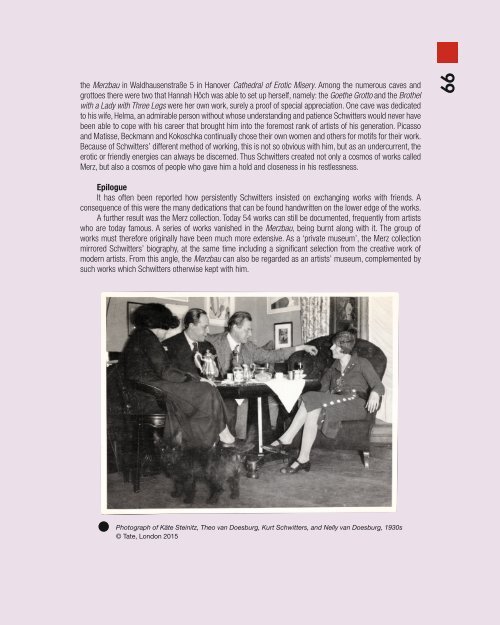Kurt Schwitters: Merz (2016) – Norman Rosenthal interviews Damien Hirst
Fully illustrated catalog published by Galerie Gmurzynska in collaboration with Cabaret Voltaire Zurich on the occasion of Kurt Schwitters: MERZ, a major retrospective exhibition celebrating 100 years of Dada. The exhibition builds and expands on the gallery’s five decade long exhibition history with the artist, featuring exhibition architecture by Zaha Hadid. Edited by Krystyna Gmurzynska and Mathias Rastorfer. First of three planned volumes containing original writings by Kurt Schwitters, historical essays by Ernst Schwitters, Ad Reinhardt and Werner Schmalenbach as well as text contributions by Siegfried Gohr, Adrian Notz, Jonathan Fineberg, Karin Orchard, and Flavin Judd. Foreword by Krystyna Gmurzynska and Mathias Rastorfer. Interview with Damien Hirst conducted by Norman Rosenthal. Includes full color plates and archival photographs. 174 pages, color and b/w illustrations. English. ISBN: 978-3-905792-33-1 The publication includes an Interview with Damien Hirst by Sir Norman Rosenthal about the importance of Kurt Schwitters's practice for Hirst's work.
Fully illustrated catalog published by Galerie Gmurzynska in collaboration with Cabaret Voltaire Zurich on the occasion of Kurt Schwitters: MERZ, a major retrospective exhibition celebrating 100 years of Dada. The exhibition builds and expands on the gallery’s five decade long exhibition history with the artist, featuring exhibition architecture by Zaha Hadid.
Edited by Krystyna Gmurzynska and Mathias Rastorfer.
First of three planned volumes containing original writings by Kurt Schwitters, historical essays by Ernst Schwitters, Ad Reinhardt and Werner Schmalenbach as well as text contributions by Siegfried Gohr, Adrian Notz, Jonathan Fineberg, Karin Orchard, and Flavin Judd.
Foreword by Krystyna Gmurzynska and Mathias Rastorfer.
Interview with Damien Hirst conducted by Norman Rosenthal.
Includes full color plates and archival photographs.
174 pages, color and b/w illustrations.
English.
ISBN:
978-3-905792-33-1
The publication includes an Interview with Damien Hirst by Sir Norman Rosenthal about the importance of Kurt Schwitters's practice for Hirst's work.
Create successful ePaper yourself
Turn your PDF publications into a flip-book with our unique Google optimized e-Paper software.
the <strong>Merz</strong>bau in Waldhausenstraße 5 in Hanover Cathedral of Erotic Misery. Among the numerous caves and<br />
grottoes there were two that Hannah Höch was able to set up herself, namely: the Goethe Grotto and the Brothel<br />
with a Lady with Three Legs were her own work, surely a proof of special appreciation. One cave was dedicated<br />
to his wife, Helma, an admirable person without whose understanding and patience <strong>Schwitters</strong> would never have<br />
been able to cope with his career that brought him into the foremost rank of artists of his generation. Picasso<br />
and Matisse, Beckmann and Kokoschka continually chose their own women and others for motifs for their work.<br />
Because of <strong>Schwitters</strong>’ different method of working, this is not so obvious with him, but as an undercurrent, the<br />
erotic or friendly energies can always be discerned. Thus <strong>Schwitters</strong> created not only a cosmos of works called<br />
<strong>Merz</strong>, but also a cosmos of people who gave him a hold and closeness in his restlessness.<br />
99<br />
Epilogue<br />
It has often been reported how persistently <strong>Schwitters</strong> insisted on exchanging works with friends. A<br />
consequence of this were the many dedications that can be found handwritten on the lower edge of the works.<br />
A further result was the <strong>Merz</strong> collection. Today 54 works can still be documented, frequently from artists<br />
who are today famous. A series of works vanished in the <strong>Merz</strong>bau, being burnt along with it. The group of<br />
works must therefore originally have been much more extensive. As a ‘private museum’, the <strong>Merz</strong> collection<br />
mirrored <strong>Schwitters</strong>’ biography, at the same time including a significant selection from the creative work of<br />
modern artists. From this angle, the <strong>Merz</strong>bau can also be regarded as an artists’ museum, complemented by<br />
such works which <strong>Schwitters</strong> otherwise kept with him.<br />
Photograph of Käte Steinitz, Theo van Doesburg, <strong>Kurt</strong> <strong>Schwitters</strong>, and Nelly van Doesburg, 1930s<br />
© Tate, London 2015

















